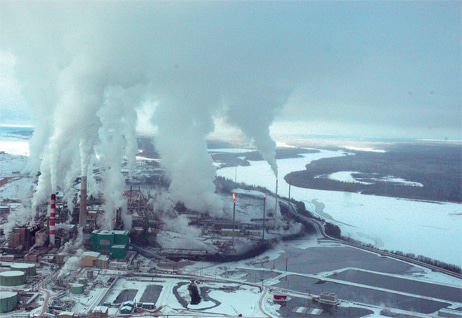According to Environment Canada’s peer-reviewed July report on Canada’s Emissions Trends [pdf], government action to date is not putting the country on track to meet the carbon emissions reductions it commited to in 2009.
A year and a half ago at the international climate talks in Copenhagen, the federal government committed to reducing emissions 17 percent below 2005 levels, by 2020. The report makes clear that the federal government’s existing measures do little and more closely resemble a carbon intensive business-as-usual development scenario.
Environment Canada’s Energy, Emissions and Economy modeling tool pulls in data from across federal government departments and shows that current government plans and programs will take the country only one quarter of the way to achieving the 2020 reductions it agreed to under the Copenhagen Accord.
In 2009, Canada said it would ultimately reduce its annual emissions to 607 megatonnes, a figure that could realistically be achieved through concerted planning. Unfortunately, the Canadian government does not take climate change seriously and existing climate programs will achieve only 65 megatonnes of reductions by 2020.
2005 2010 2020
Emissions Assuming No Government Measures 731 718 850
Emissions With Existing Government Measures 731 710 785
Difference Impact of Existing Government Measures 0 -8 -65
The report is 60 pages long, and it is clear that the only chance Canada has to live up to its 2020 commitments is to rely on unknown or non-existent future government measures. The few federal initiatives that are in place include fuel efficiency regulations for light-duty vehicles, renewable fuels standards and the Emissions Performance Standard for coalfired electricity (with coal being promoted again in Alberta).
Runaway carbon emissions in the oil and gas sector will continue through 2020. In 1990 the sector as a whole released 101 megatonnes of carbon into the atmosphere, and in 2008 the figure was 158 megatonnes. By 2020 the figure will be 199 megatonnes.
The growth in oil and gas emissions comes mainly from the near doubling of oil sands production, the majority of which is located in Alberta. The oil sands comprise some 6.5 percent of the country’s total carbon emissions and the U.S. Environmental Protection Agency describes this dirty oil as 82 percent more carbon intensive than average oil.
In June, Canada submitted a 567 page report and inventory of its carbon emissions. The government was heavily criticized for not including 2009 data which showed the significant growth in unchecked oil sands pollution.
The oil sands continues to be a blight on Canada-wide efforts to control carbon output. Recently, internal emails released from Natural Resources Canada show the collusion between the governing federal Conservatives, their Alberta provincial counterparts, as well as the Canadian Association of Petroleum Producers in order to come up with a common strategy to “turn up the volume” and get “the right attitude” on oil sands advocacy.
Even if these groups are unable to get their messaging right, Alberta’s Energy Minister Ron Liepert is straightforward with his priorities saying that his province does not want Canada to meet its carbon and clean air commitments:
“I’m not interested in Kyoto-style policies. That’s something that was the previous Liberal government. We’re working with the current government to ensure that we do what we can, but at the same time we’re not going to cripple the Canadian economy.”
Simon Dyer, policy director at the Pembina Institute, speaks positively of the importance of the Environment Canada report and of the oil sands impact saying:
“This is the first time we’ve seen just exactly the difference between the different sectors, and just how out of line the oil sands emissions are.”
“Environment Canada’s projections make it crystal clear that the oil sands will only continue to be one of this country’s most urgent emissions problems in the coming decade and beyond.”
The oil sands will account for 12 per cent of national emissions by 2020 and “That’s more than any province other than Alberta and Ontario, and is 40 per cent more than Quebec’s total projected emissions in 2020,” adds Dyer.
Although Canada will not live up to its carbon emissions requirements, the government is on target to meet its plan to eliminate jobs and cull Environment Canada’s capacity to deal with climate change. Earlier this year it was reported that Environment Canada is facing 14 percent in funding cuts (or $222 million) with the budget to address carbon emissions and to fight air pollution to drop 59 percent (from $240 million to below $100). Last week, 776 employees at Environment Canada, many who work on meteorological and climate change issues, will be transferred or laid off.
William Pynn, head of the Union of Environment Workers, says:
“The cuts are so massive that the support mechanism for the research that Environment Canada does … is certainly going to be challenged.”
As well, John Bennett, the executive director of Sierra Club Canada says:
“This is not about the deficit. This is about a blatant disregard for need to protect our natural heritage.”
“It will give the polluters what they want, a toothless Environment Canada with no scientific or enforcement capability.”
Photo Credit: Northern Insights Blog
Subscribe to our newsletter
Stay up to date with DeSmog news and alerts






